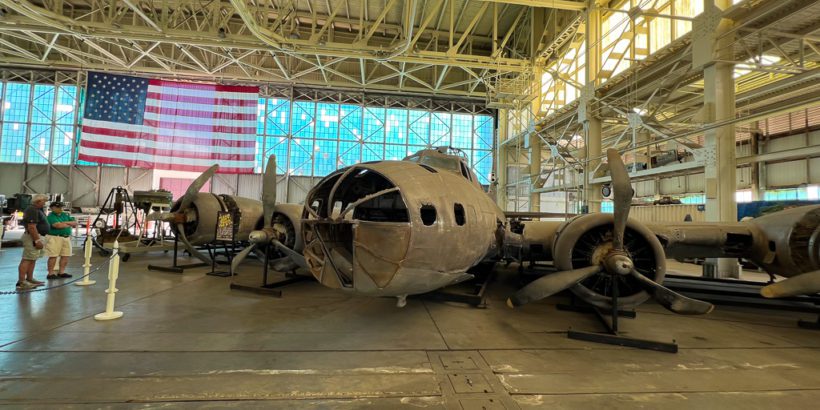When Pearl Harbor was attacked almost all of the damage came from the air and perhaps the best place to get a sense of what those enemy attackers looked like is the Pearl Harbor Aviation Museum.
It’s one of the attractions located on historic Ford Island and it’s definitely worth adding to your itinerary if you can find the time.
Below, I’ll explain more about the museum and give you an idea of what you can expect when you visit including highlighting some of the most interesting things to check out.
Table of Contents
What is the Pearl Harbor Aviation Museum?
The Pearl Harbor Aviation Museum is home to several aircraft and original artifacts involved in the Pearl Harbor attacks.
You’ll explore two airport hangars, an outdoor aircraft lot, and a control tower, which all allow you to experience the unique history of this place in a different way.
This museum is special in that it is located at ground zero for the Pearl Harbor attacks.
I’ve been to some aviation museums before and always enjoyed my time but this one just feels different. The history is palpable.
Tip: If you want to buy tickets to multiple Pearl Harbor attractions (USS Bowfin, Pacific Aviation Museum, and Battleship Missouri) check out this option online.
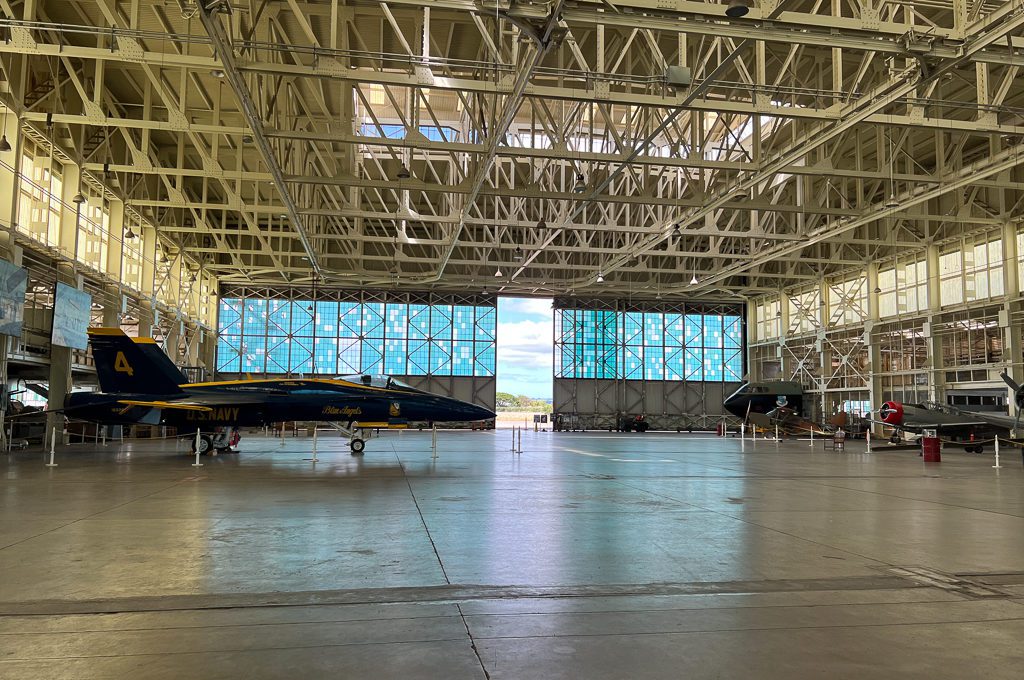
How to visit the Pearl Harbor Aviation Museum
The Pearl Harbor Aviation Museum is located on historic Ford Island, Hawaii, which is an active military base that can only be accessed by a shuttle bus (unless you have some other type of special permission).
The shuttle bus station is located on the north side of the Pearl Harbor Historic Sites Visitor Center. It’s basically on the opposite side of the station for the shuttle boat to the USS Arizona Memorial.
If you plan on visiting the USS Missouri and USS Oklahoma Memorial, you should first get dropped off by the bus at that stop and then when you finish up there you can hop back on the shuttle bus and make your way to the Pearl Harbor Aviation Museum.
That will make things a lot easier because the shuttle bus only runs one way.
Shuttles depart every 15 minutes from 8am to 5pm daily but the Pearl Harbor Aviation Museum is only open from 9am to 5pm.
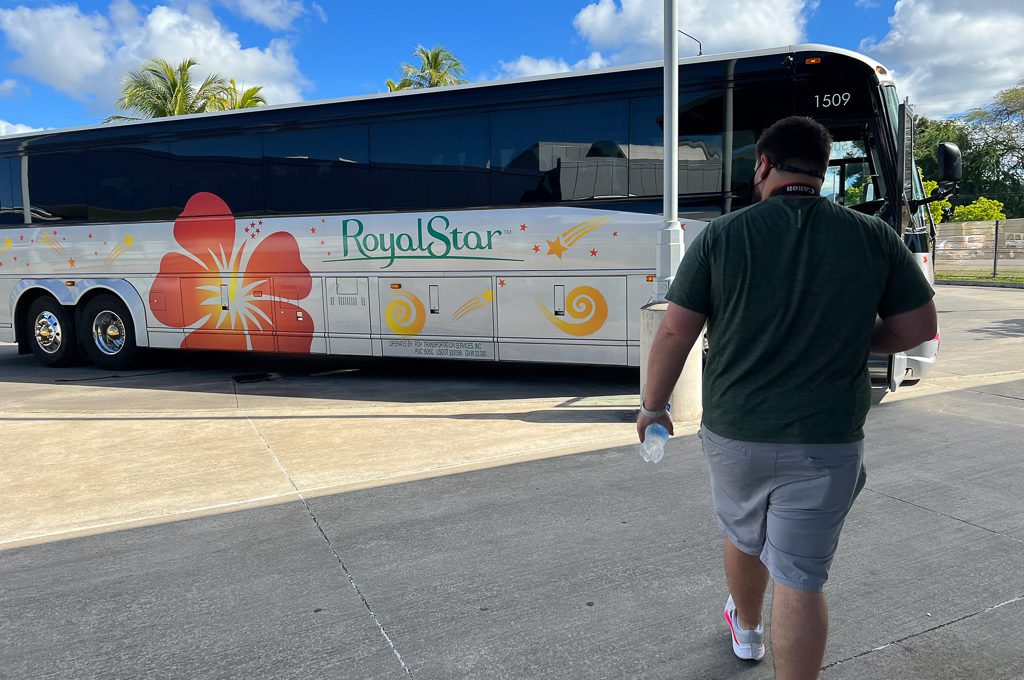
For security purposes, no bags are allowed on the shuttle bus to Ford Island.
A bag storage facility at the USS Bowfin Submarine Museum & Park shuttle bus stop can store your belongings for a fee of $5.00 per bag. Credit cards are accepted.
You can buy tickets for the Pearl Harbor Aviation Museum online or in-person at the following rates:
- Adults: $25.99
- Children: $14.99 (ages 4-12)
Experiencing the Pearl Harbor Aviation Museum
Hangar 37
Your first stop will be Hangar 37, where the shuttle bus will drop you off.
When the attack happened, this hangar housed nine Grumman J2F “Ducks” and nine Sikorsky JRS-1s.
Soldiers on the ground used the mounted machine guns on the grounded J2Fs to defend the island. Meanwhile, five JRS-1s departed Hangar 37 to find the Japanese fleet (but were unsuccessful).
The hangar also provided shelter to the survivors of the battleship USS California.
So thousands of lives were permanently altered on the grounds you’re stepping on and countless acts of bravery took place on these premises.
Getting started
After showing your tickets to the front desk you will begin your journey to the museum.
You should see the gift shop and the Laniākea Cafe restaurant located right by the entrance and also nearby is a 200-person theater that you can pop into to catch a short film about Pearl Harbor.
That will give you some history and then you’ll be ready to head into the main part of the museum.
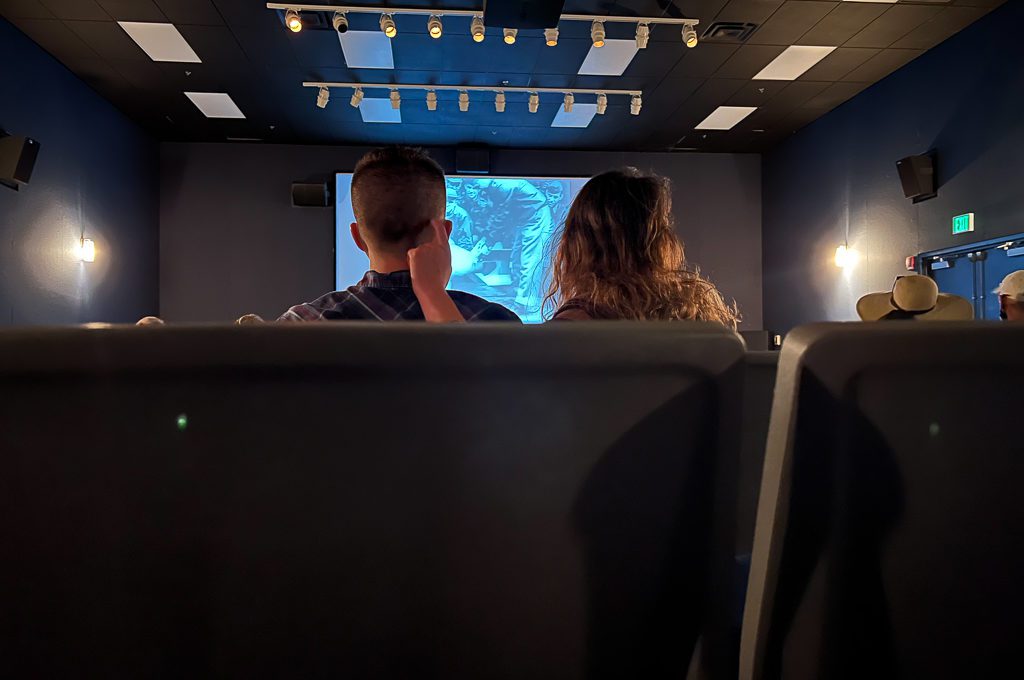
Mitsubishi A6M Zero
One of the main attractions at the museum is the Mitsubishi A6M Zero or simply “Zero,” which is the name used for these Japanese planes made by Mitsubishi.
They get their name from the last digit of the year that they were launched which was the year 2600 according to the Japanese Imperial calendar.
These were state of the art planes and the most equipped carrier planes when they were launched in 1940. Japan also produced more of these (10,000+) than any other model of combat aircraft.
Their lightweight design made them extremely fast and maneuverable and gave them a lot of range but also made them vulnerable to gunfire. Nine Zeros were shot down during the attack on Pearl Harbor.
Eventually, weaknesses in the Zero were discovered and the US would capitalize on them by altering their strategies of engagement.
As the Allies became more advanced with their aircraft tactics, the Zero became increasingly outdated and eventually was adapted for kamikaze attacks.
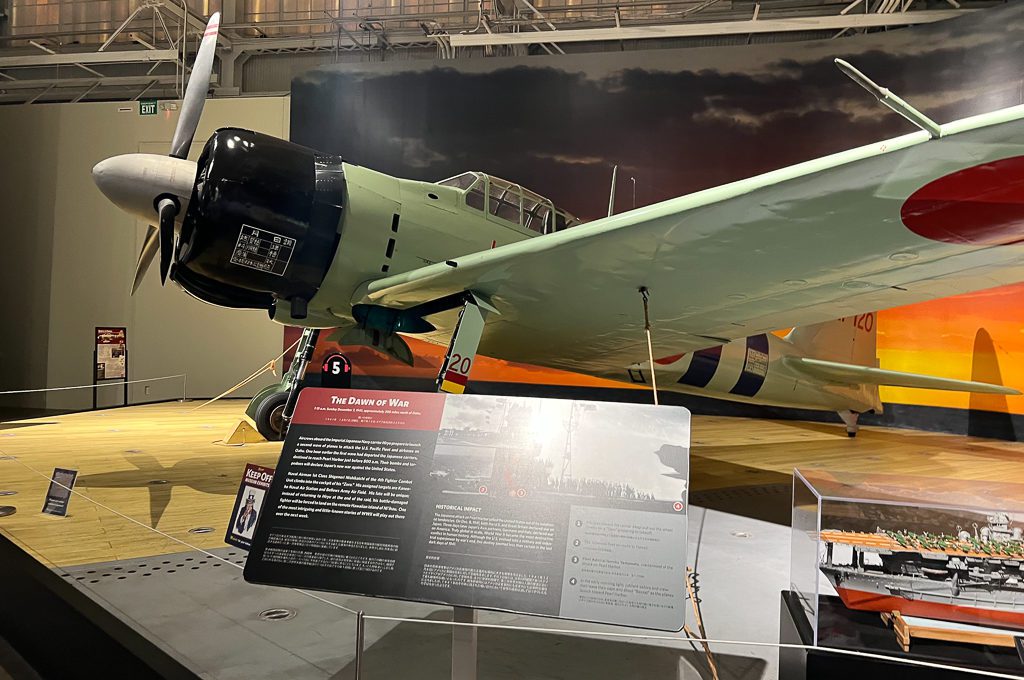
Zero Nishikaichi (the Niihau incident)
At first glance, the remains of the The Zero Nishikaichi look like in an uninteresting pile of scrap. But these rusted remnants are actually part of a fascinating story related to the Pearl Harbor attacks.
Pilot Shigenori Nishikaichi flew this Zero during the second wave of attacks and was forced to make a crash landing on the island of Niihau, which is just off the coast of Kauai, Hawaii.
A local Hawaiian, Kaleohano, then discovered him and took his papers and pistol.
Kaleohano did not know about the attack on Pearl Harbor yet but he realized this was a Japanese pilot and knew that relationships were strained between the US and Japan.
The locals provided a hospitable welcome for the pilot but struggled to communicate with him so they brought in two Hawaiians of Japanese descent, the Haradas.
Nishikaichi shared the news of the Pearl Harbor attack in Japanese with the couple but they kept that news a secret.
This married couple had sympathy for the pilot and would end up trying to help Nishikaichi escape the island while also attempting to retrieve his confidential papers and pistol.
But as locals on the island discovered what happened at Pearl Harbor via radio broadcast, they quickly turned on Nishikaichi.
Ultimately, a situation played out overnight where Nishikaichi and Harada, armed with a shotgun and pistol, stormed Kaleohano’s house only for him to get away.
Nishikaichi and Harada then initiated a manhunt for Kaleohano, while putting the island intro a frenzy.
Ben Kanahele, who had been captured along with his wife by the duo, ended up getting into a fight with them. During the scuffle, Kanahele killed Nishikaichi with a hunting knife despite being shot three times by the pilot.
Meanwhile, Harada took his own life with a shotgun.
It was a very crazy situation and unfortunately it was likely a contributing factor to the government setting up Japanese internment camps based on an official Navy report dated January 26, 1942.

Nakajima B5N “Kate”
There’s also a Nakajima B5N or just “Kate,” which was the first all metal monoplane aircraft in the Imperial Japanese arsenal.
Japan’s premier carrier-based torpedo bomber, these were integral to the Pearl Harbor attack and 144 of these planes took part in the attack, arriving in both waves.
They also played a role in battles at the Coral Sea, Midway, and Santa Cruz Islands.
The Kate you’ll see at the museum is an extremely rare find.
In fact, it’s one of only two Kates in existence, even though over 1,000 were produced.
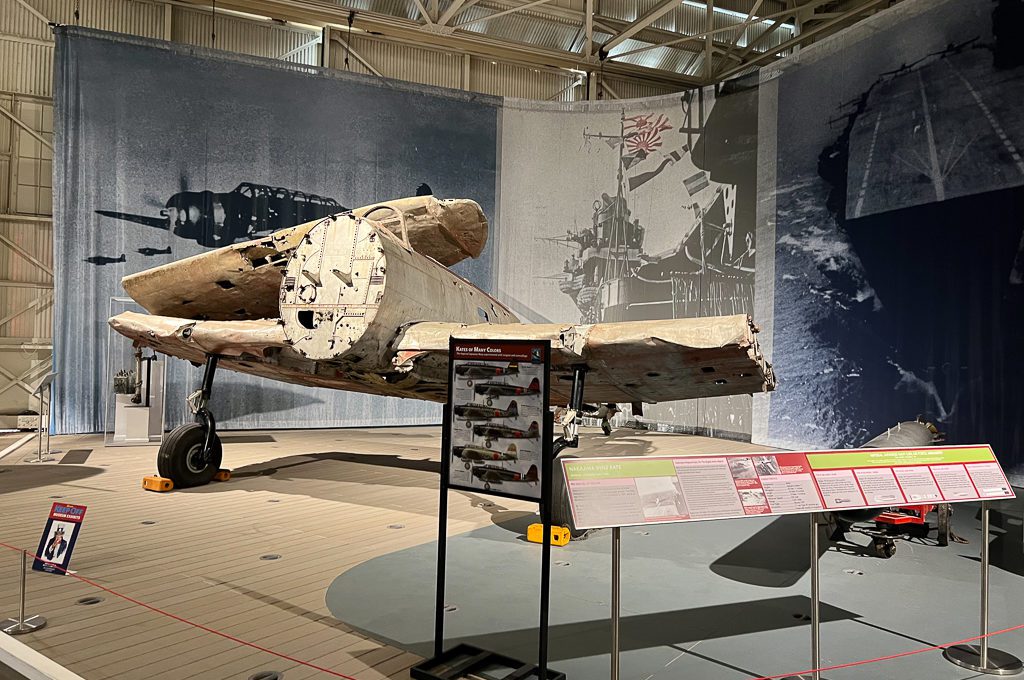
Boeing N2S-3 Stearman (Trainer)
The “big yellow plane” hanging in the museum is the Boeing N2S-3 Stearman.
This one is especially noteworthy because it was used by former President George H. W. Bush on December 15, 1942, while participating in flight training at Naval Air Station, Minneapolis, MN.
Another interesting aircraft to check out is the Grumman F4F-3 Wildcat, which was used by the US to combat the Zeros and quite a successful US Naval fighter. It was famously used a lot when pilots engaged in the “Thach Weave” (video).
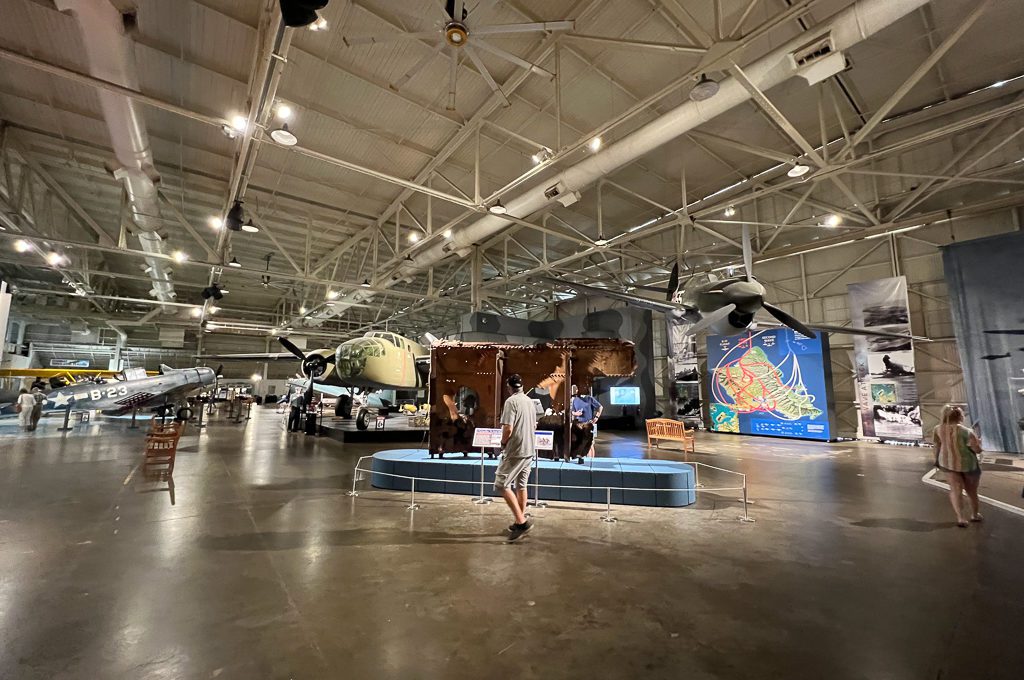
There are some other interesting exhibits to check out in the hangar.
One of the more helpful exhibits was a large diagram that illustrates the first and second waves of the Pearl Harbor attacks.
It does a really good job of giving you an idea of the direction that the attacks came from and also showing you some of the other targets that were hit on Oahu.
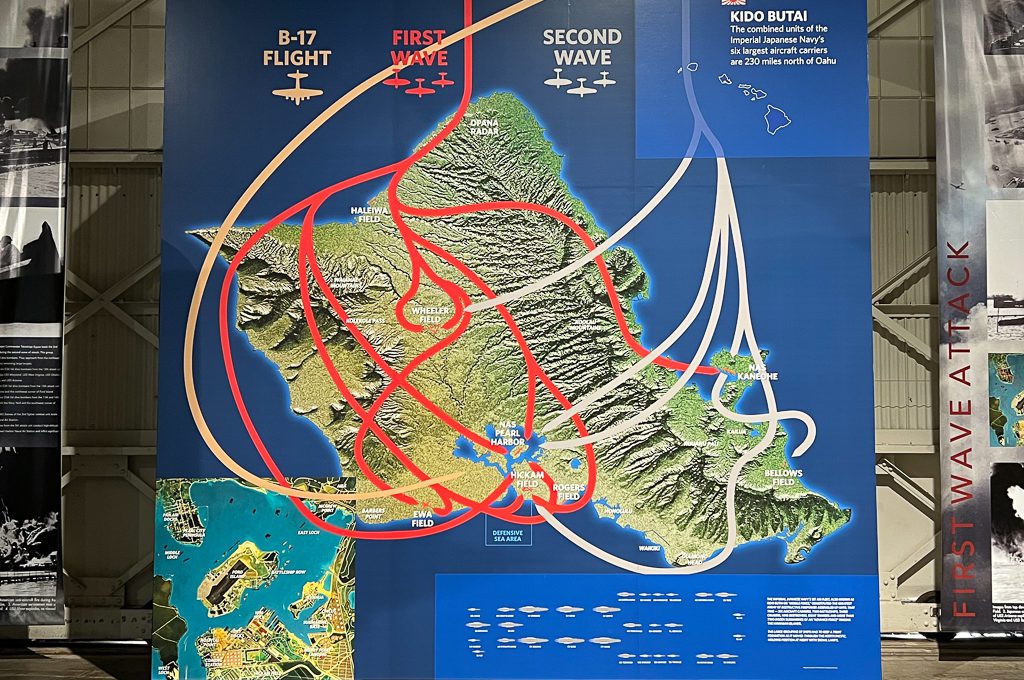
Fighter Ace 360 Flight Simulators
If you’re looking for a bit of a thrill ride then consider giving the Fighter Ace 360 Flight Simulators a try.
My biggest regret on visiting the museum is that we did not try this out because in retrospect it looks freaking awesome.
It’s only about $22 for two people and this thing can take you fully inverted for the ultimate flight experience.
You can experience a dog fight with Thunder in the Pacific or get futuristic and partake in some space travel with Quantum Star Fighter.
Outdoor collection
Once you get finished with Hangar 37 you will head outside and make your way to Hangar 79 but on the way you’ll probably want to make a pitstop at the outdoor collection.
Between the two hangers there is an outdoor area where different helicopters and planes are on display.
You’ve probably heard of the Blackhawk but have you heard of the Seahawk?
One helicopter that stuck out to me was the Sikorsky SH-60B Seahawk which was sort of the Navy’s version of the Blackhawk.
Equipped with one torpedo on each side, a 30mm gun, and Hellfire missiles, it specialized in anti-submarine warfare, mine clearing, anti-ship warfare, and insertion of Navy SEALS.
If you look on the left side of the helicopter you’ll see 25 tube openings which look a bit peculiar. These are made to send out sonobuoys that allow a crew to detect submarines.
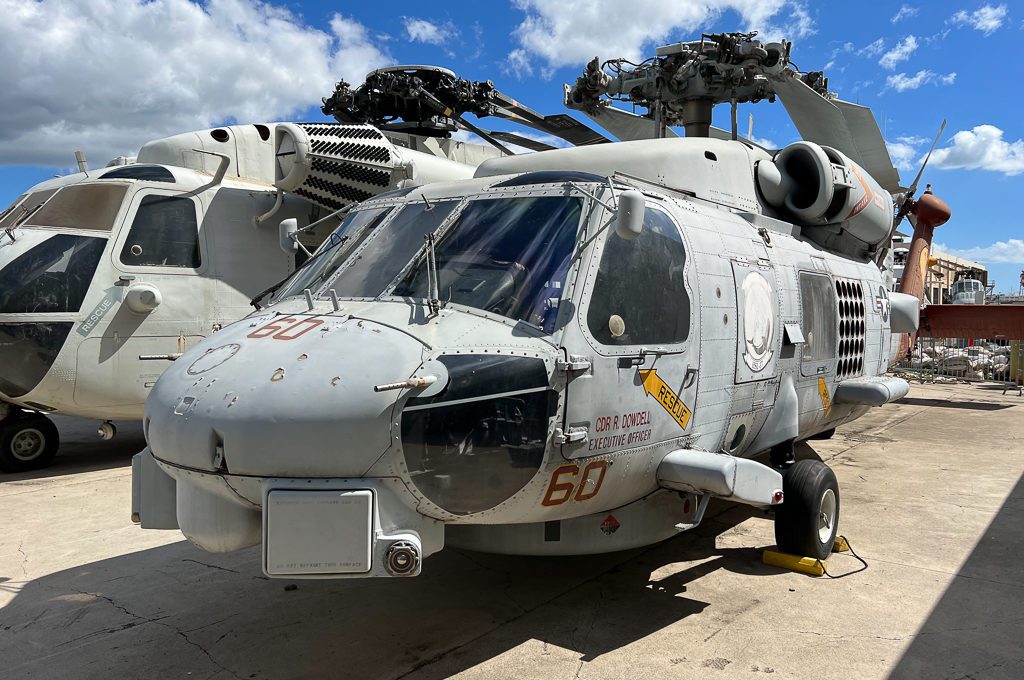
There’s quite a few aircraft outside so you’ll want to allocate some time to wander around and check these out.
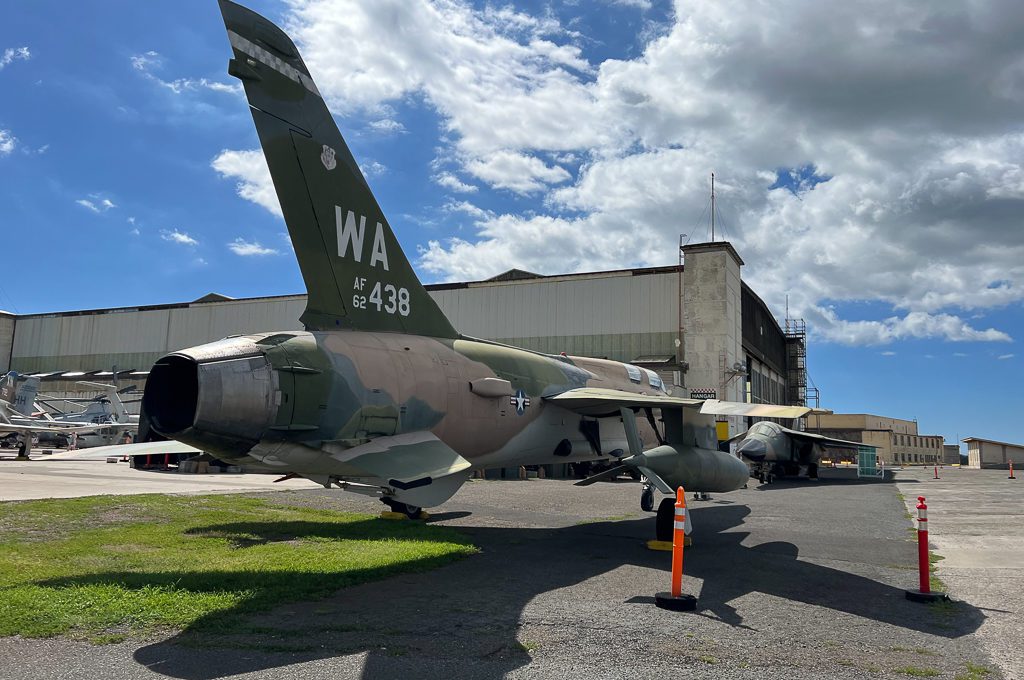
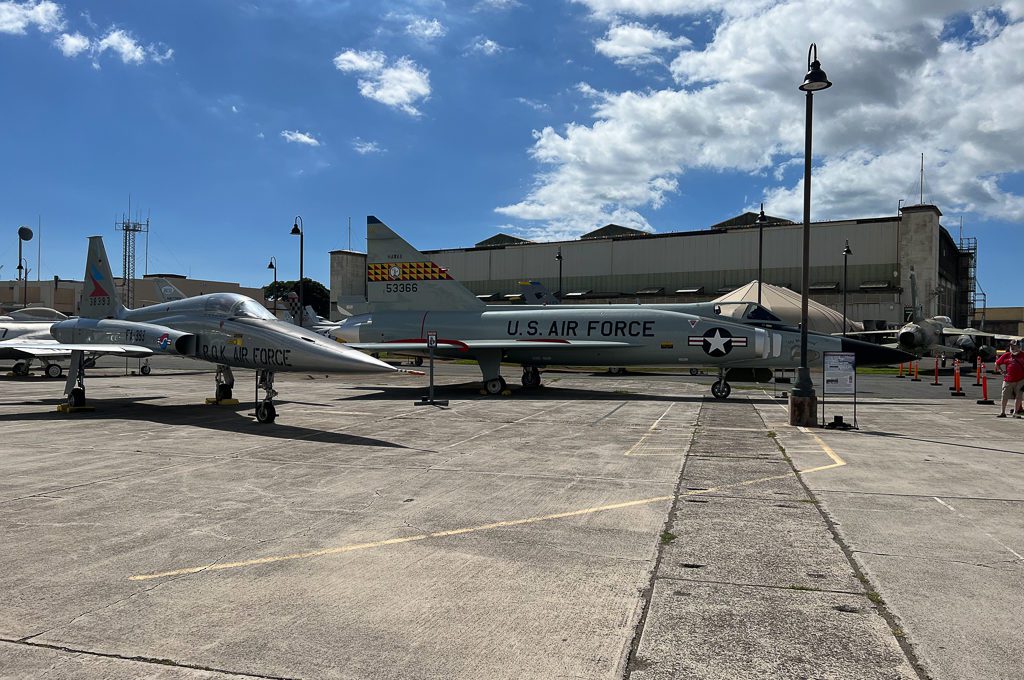
Raytheon Pavilion
The Raytheon pavilion is located between the two hangers and it houses an “ever-changing roster of experiences with traveling exhibits.”
When we visited, there was an exhibition on Bob Hope who was a comedian, actor and entertainer who helped keep the spirits high for service men and women on the front lines of World War II.
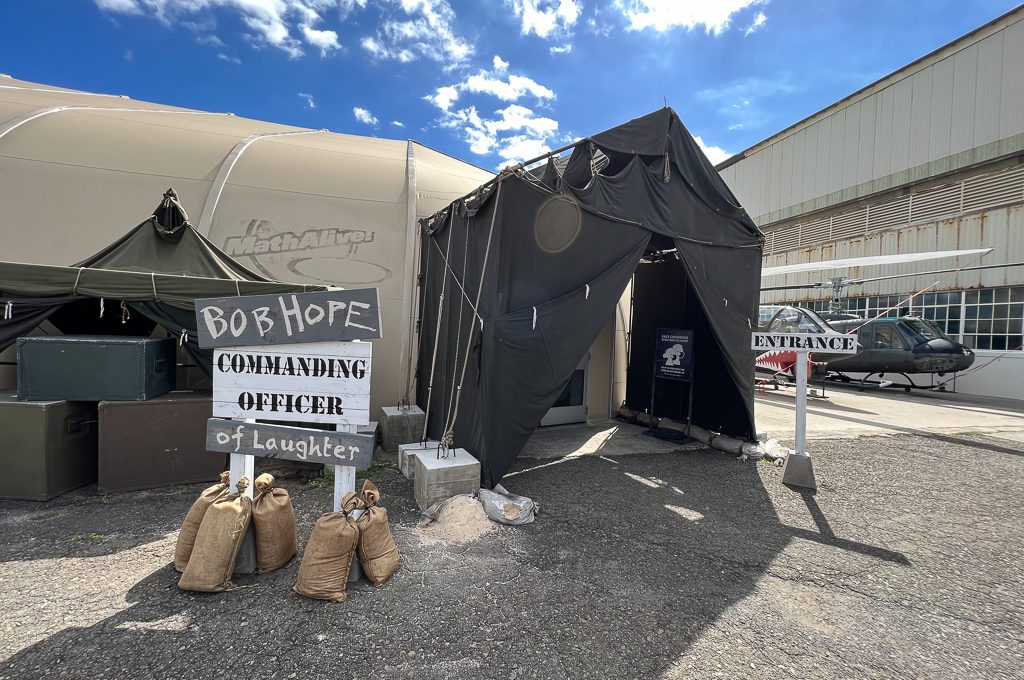
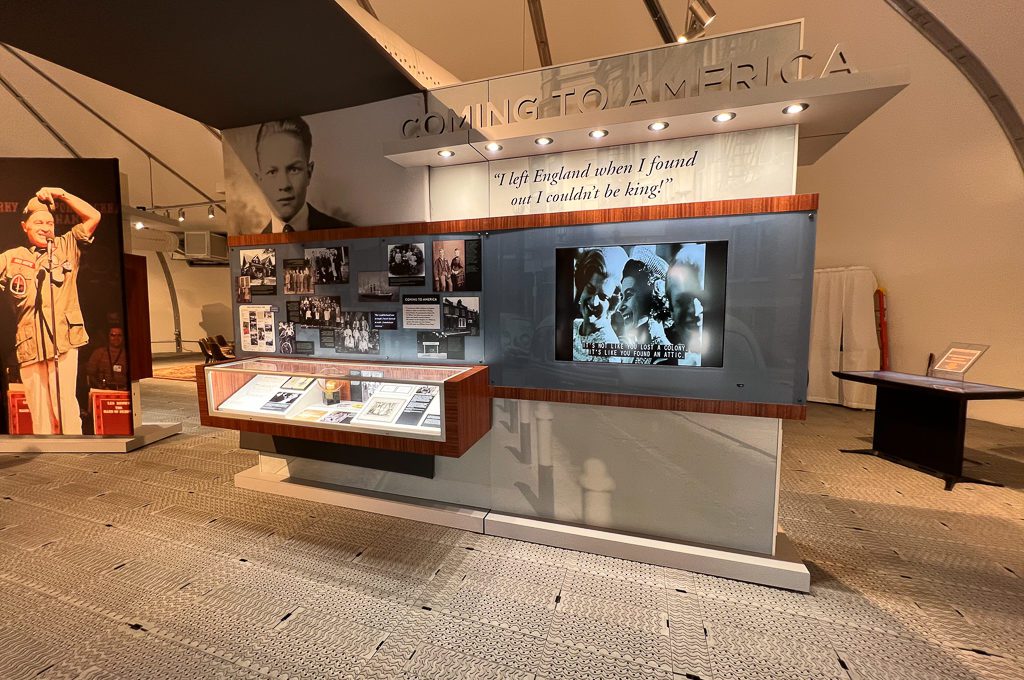
Hangar 79
The other major structure that makes up the Pearl Harbor Aviation Museum is Hangar 79.
Hangar 79 was undergoing a lot of construction when we were there and the vast majority of the hangar was blocked off.
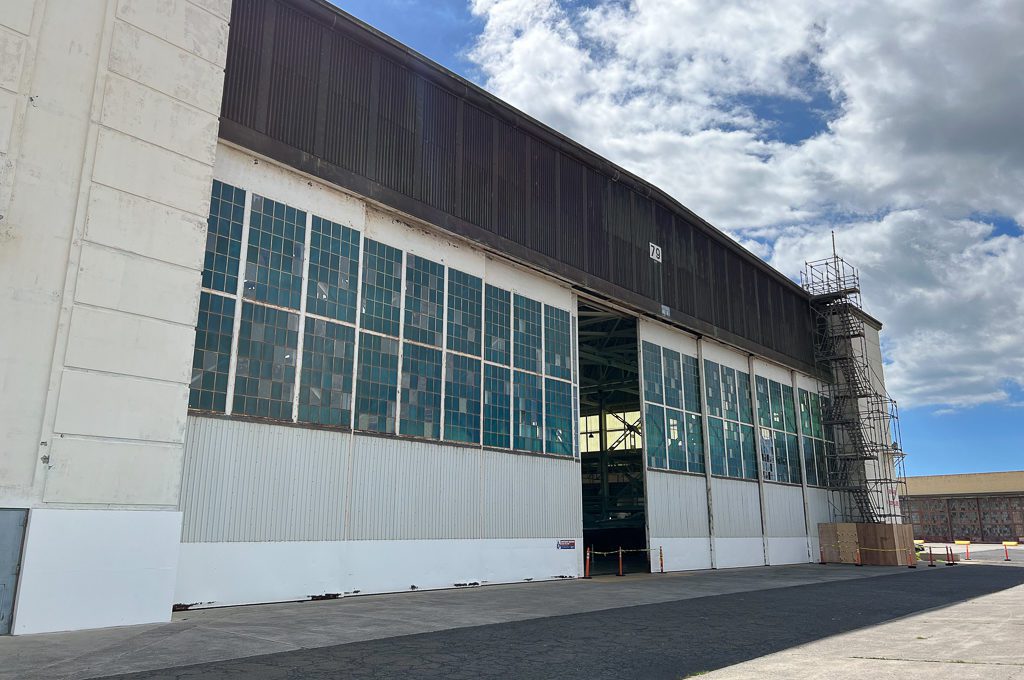
Once inside, we got a glimpse of one of the Blue Angels and the B-17 “Swamp Ghost.”
This B-17 aircraft, which originally arrived in Honolulu 10 days after the Pearl Harbor attack, has a pretty fascinating story as the pilot had to perform an emergency landing in Agaiambo Swamp in Australia.
The aircraft remained there for decades and only recently was restored and brought back to the US in 2014.
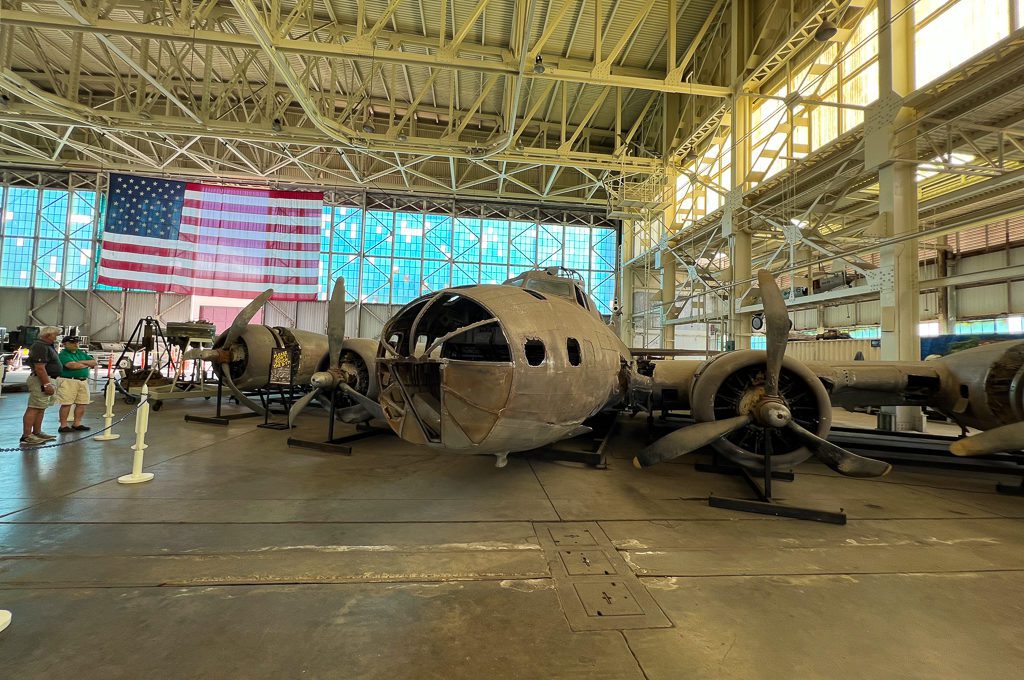
We also saw the Shealy Restoration Shop in action, which is a “genuine aircraft restoration shop that maintains and restores authentic aircraft from World War II and beyond.”
If you want to go behind the scenes of the restoration shop, book the guided Legends of Pearl Harbor Tour.
While I enjoyed exploring the hangar, I don’t believe we were able to get the full experience that Hangar 79 typically has to offer since so many things were blocked off.
Still, one thing that we did see were all of the bullet holes in the windows which are from the Pearl Harbor attack.
To me, that is the most moving aspect of the entire museum.
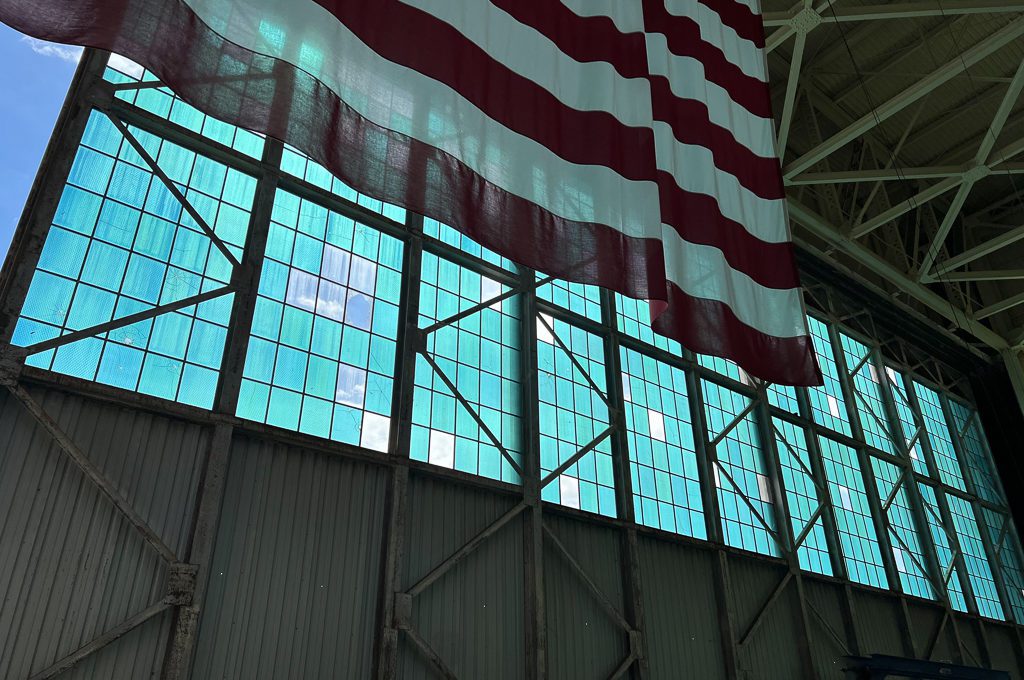
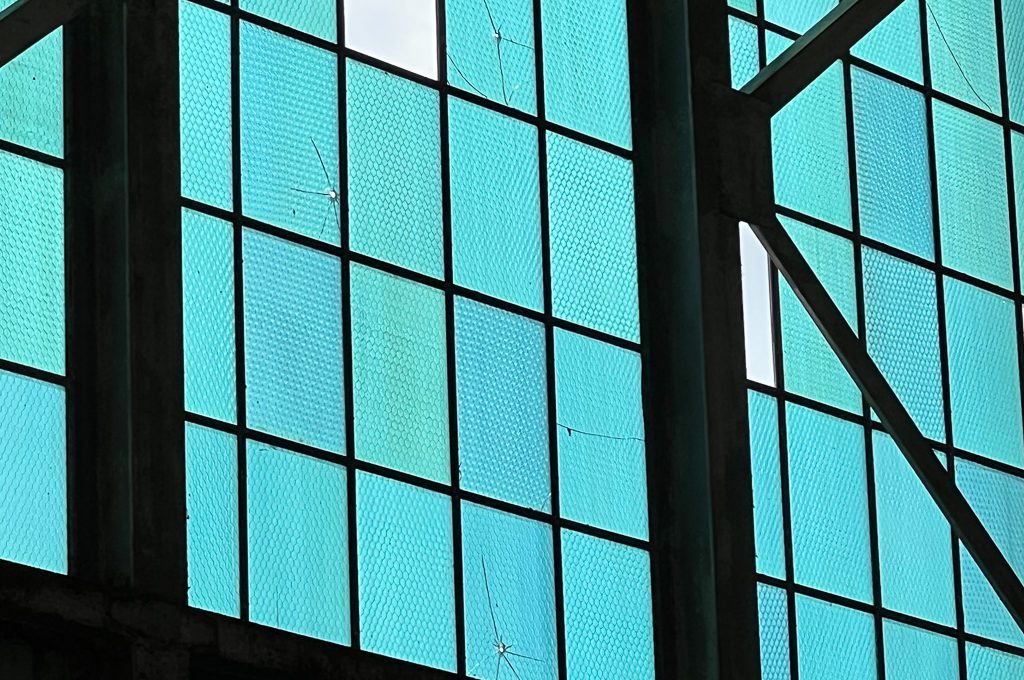
Control Tower
It was at this control tower where the first radio broadcast of the attack on Pearl Harbor was made at 8:05 a.m. on Dec. 7, 1941.
“AIR RAID ON PEARL HARBOR X THIS IS NOT DRILL.”
At the time of the radio announcement, the structure was being bombed and windows on the lower levels were shattering.
The Control Tower at Pearl Harbor has undergone a lot of recent renovations but unfortunately those were not fully complete when we visited.
But soon the tower will be complete and you’ll be able to take an elevator all the way to the top where you will have 360° views of Ford Island and the surrounding harbor.
Update: the tower is now open and you can visit it by scheduling a tour for around $20.
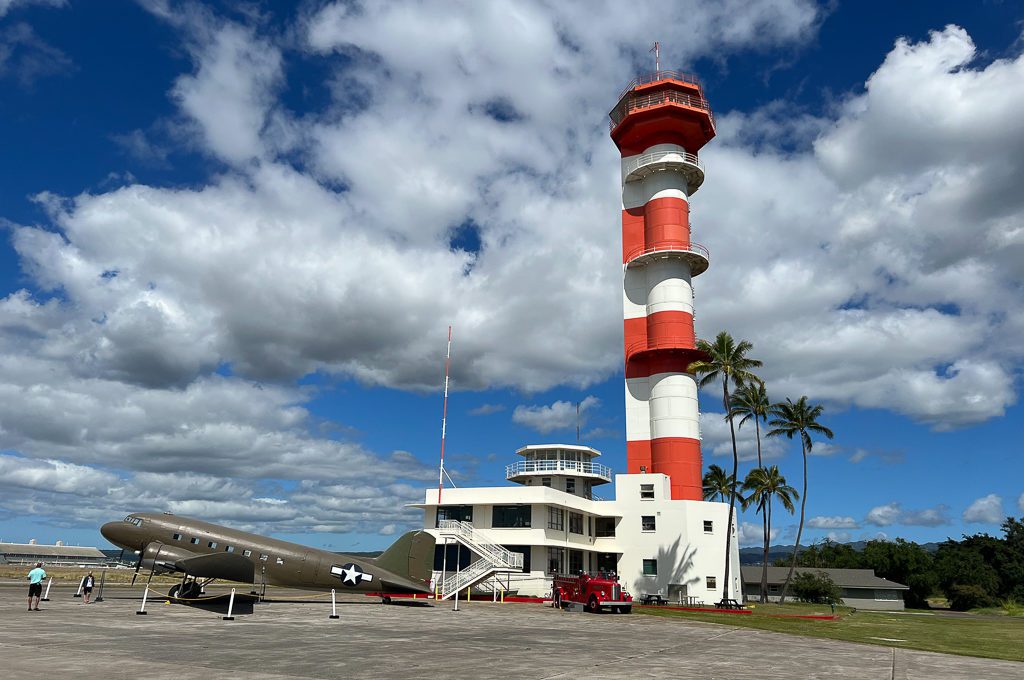
Final word
It felt like our experience here was a little bit limited because of some of the ongoing renovations but it was still worth checking out.
You’ll no doubt feel the history as you wander the premises and check out everything from the bullet holes left in the windows to some of the rare aircraft on display.
During my time on the shuttle bus, I overheard people talking about skipping the aviation museum but I would highly recommend you to give it a shot because there’s a lot to take in here.
Daniel Gillaspia is the Founder of UponArriving.com and the credit card app, WalletFlo. He is a former attorney turned travel expert covering destinations along with TSA, airline, and hotel policies. Since 2014, his content has been featured in publications such as National Geographic, Smithsonian Magazine, and CNBC. Read my bio.

